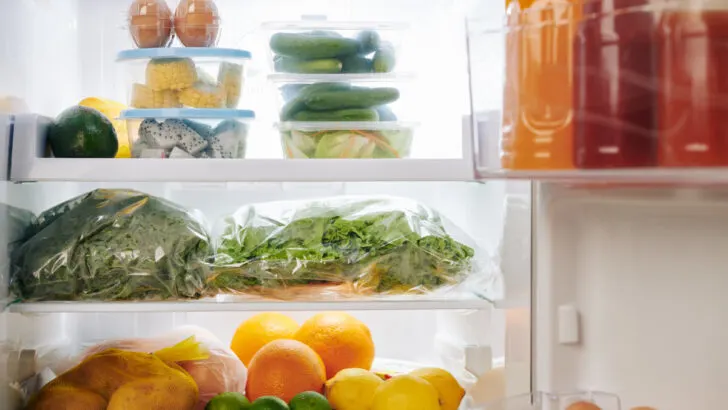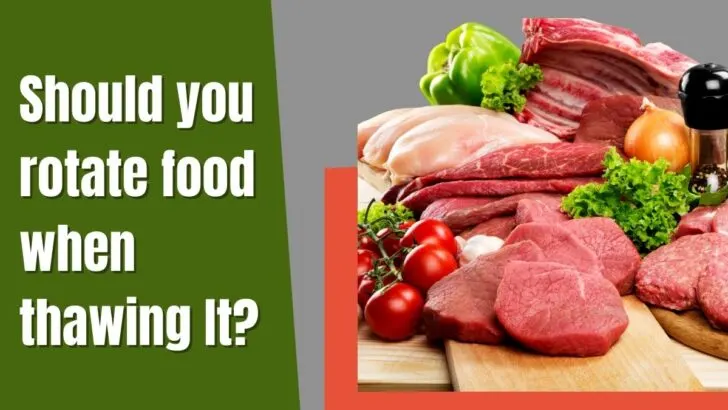Freezers are a blessing in disguise when you want to freeze your leftover meal for another day. However, the thawing process takes time and sometimes even spoils your food. Also, another debate about thawing is if you should rotate your frozen food or not.
You should rotate your frozen meals during the thawing process to ensure your food reaches the optimal temperature securely and efficiently. This method prevents the ice from adhering to some of your food. Rotating in some shifts can reveal any covered, trapped, or chunked ice from your food.
If you’re still unsure whether to rotate the frozen food, read on to learn more about the benefits of doing so and the science behind it. So let’s get started.
What Are Various Thawing Techniques?
Here are the top 3 methods for defrosting food:
Thawing in Cold Water
The process of thawing frozen foods—like a frozen turkey—in a sink or other receptacle of cold water is known as “cold water thawing.”
Ensure the food is thoroughly immersed and replace the water every 20 minutes to avoid contamination. In roughly six hours, the food should have thawed entirely.
A quick thaw can be achieved by placing frozen food in cold water. However, there are additional considerations, such as the sort of food and how long it has been frozen. The water must be cold, so the ice only melts slowly.
It should be at least 40 degrees Fahrenheit below that. To stop bacteria from spreading, always use clean water.
Thawing in A Refrigerator
Food in a refrigerator is defrosted during the thawing process. Foods like raw meat or chicken are prepared using this method when they don’t need to be cooked quickly.
Since this method does not use heat, which might encourage the growth of bacteria, it is crucial to use it while preparing these foods.

However, how long something takes to defrost in the fridge is determined by the size and temperature of the fridge. Except for raw meat or poultry, this procedure is safe for most items.
Raw meat or poultry left in the refrigerator for an extended period may contaminate other foods, necessitating their disposal. The only way to ensure the safety of thawing meat or poultry is to cook it afterwards quickly.
Thawing in a Microwave
Commercial meal preparation methods sometimes involve using a microwave to thaw frozen food. Microwaves are used for cooking food to a safe temperature throughout this process.
Microwaves cook food by causing the water molecules within it to vibrate, which releases heat. One shouldn’t use a microwave when defrosting raw meat, poultry, or shellfish.
Meat may be quickly and safely thawed in the microwave. All you require is a microwave, a plastic bag, and a bowl that can be used in one.
Microwave the meat on high for a minute for each pound, with the plastic bag resting on the top of the basin but not touching the bowl itself.
The frozen meat should be heated without being overcooked. Allow your food to cool for 3 minutes after microwaving it for 1 minute per pound, and then consume it.
Why You Should Rotate Food As It Thaws
Large food items, like a whole turkey, should be rotated to evenly thaw. You can greatly reduce your risk of food poisoning by turning the turkey in the right direction. Also, doing so will result in cooking much more quickly and easily.
Many people have to cope daily with bacteria growing in their meals, especially those who frequently store food in their freezers for later use. If hygiene is not prioritized, cross-contamination risk is quite significant.
One of the simplest yet most powerful solutions is rotation thawing. Using this easy technique can reduce the chance of cross-contamination and bacterial growth. Before thawing and heating your food, given its simplicity, you should keep it in mind.
The Science Underneath Rotating Food When Thawing It
If you rotate the frozen food in your freezer, it will defrost more quickly and more naturally. When there is a significant temperature difference throughout the food and the food is not rotated while it thaws, the thawing process will not be consistent.
You can rotate your food to release any air that may be trapped inside and prevent any water molecules from becoming entrapped. Aside from this, if you rotate the food while it is defrosting, it will defrost more swiftly and naturally.
Advantages Of Rotating While Thawing
Thawing is a simple yet effective technique. You must consider the significant advantages of this straightforward technique. These advantages are connected to food safety and quality.
Some of the most notable advantages of rotating your food are:
Food Quality
When defrosting frozen food, turning it occasionally can help prevent the formation of ice crystals and water droplets within the meal itself. If you do this, the overall quality of the food’s texture will increase.
Prevent Microorganisms Growth
To prevent the growth of some microorganisms, it is important to rotate your food to ensure safety. As bacterias have the potential to grow in warmth, not rotating the food will result in so. Besides, it results in food poising and other food disorders.
How To Tell If Thawed Food Is Good To Eat?
If you’re unsure whether the food you just thawed is still okay to consume, you can perform a few little tests. The visual test is the first one. See if the food’s color has altered. It is advised to avoid eating the food if there are any green regions, dark spots, or other indications of bacterial or mould growth.
Another option is to check the food’s aroma to check whether it has a peculiar, intense, or pungent smell. If something smells off, it isn’t something you want to consume.
You can also perform the texture test. Squeeze the food to test if it is excessively soft or hard. If the consistency has shifted, the food should not be consumed.
The taste test is the final test you may run. If you need clarification on whether the food has gone wrong, eat a little bit. It can go bad if the taste is off-putting or different from what it should be. It’s advisable to avoid taking any chances with potentially rotten food.
Final Words on Rotating Food As It Thaws
Thawing your frozen food is a simple task, yet it has the potential to spoil your mood too. If you’re using proper thawing techniques mentioned in the guide above, the chances of spoiling your food are slim to none.
However, one simple thing you can do to thaw your food completely is to keep rotating it. This makes your thawing process risk-free so that you can enjoy your meal without any second thoughts.


